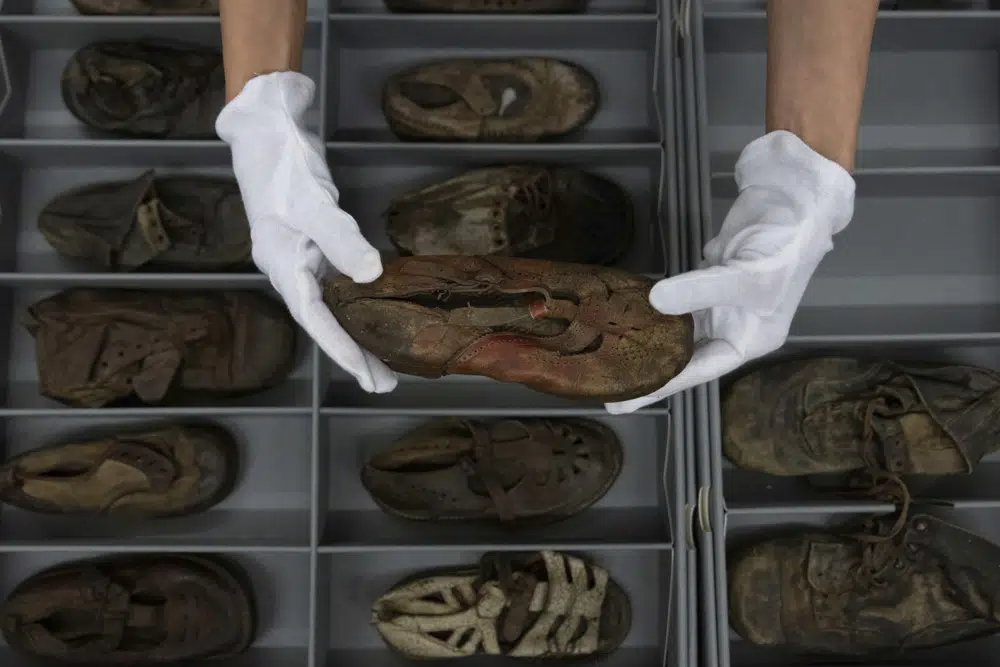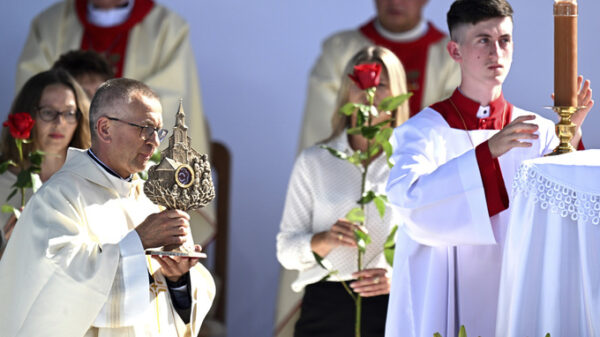Elzbieta Cajzer, head of the museum’s collections department, shows a collection of shoes that belonged to child victims of the former Nazi German death camp Auschwitz-Birkenau at the conservation laboratory on the grounds of the camp in Oswiecim, Poland, Wednesday, May 10, 2023. A two-year effort has been launched in 2023 to preserve 8,000 children’s shoes at the former concentration and extermination camp where German forces murdered 1.1 million people during World War II. (AP Photo/Michal Dyjuk)
OSWIECIM, Poland (AP) — In a modern conservation laboratory on the grounds of the former Auschwitz camp, a man wearing blue rubber gloves uses a scalpel to scrape away rust from the eyelets of small brown shoes worn by children before they were murdered in gas chambers.
Colleagues at the other end of a long work table rub away dust and grime, using soft cloths and careful circular motions on the leather of the fragile objects. The shoes are then scanned and photographed in a neighboring room and catalogued in a database.
The work is part of a two-year effort launched last month to preserve 8,000 children’s shoes at the former concentration and extermination camp where German forces murdered 1.1 million people during World War II. Most of the victims were Jews killed in dictator Adolf Hitler’s attempt to exterminate the Jews of Europe.
The site was located during the war in a part of Poland occupied by German forces and annexed to the German Reich. Today it is a memorial and museum managed by the Polish state, to whom the solemn responsibility has fallen to preserve the evidence of the site, where Poles were also among the victims. The Germans destroyed evidence of their atrocities at Treblinka and other camps, but they failed to do so entirely at the enormous site of Auschwitz as they fled the approaching Soviet forces in chaos toward the war’s end.
Eight decades later, some evidence is fading away under the pressures of time and mass tourism. Hair sheered from victims to make cloth is considered a sacred human remain which cannot be photographed and is not subjected to conservation efforts. It is turning to dust.
But more than 100,000 shoes of victims remain, some 80,000 of them in huge heaps on display in a room where visitors file by daily. Many are warped, their original colors fading, shoe laces disintegrated, yet they endure as testaments of lives brutally cut short.
The tiny shoes and slippers are especially heartrending.
“Children’s shoes are the most moving object for me because there is no greater tragedy than the tragedy of children,” said Mirosław Maciaszczyk, a conservation specialist from the museum’s conservation laboratories.
“A shoe is an object closely related to a person, to a child. It is a trace, sometimes it’s the only trace left of the child.”
Maciaszczyk said that he and the other conservation workers never lose sight of the human tragedy behind the shoes, even as they focus on the technical aspects of their conservation work. Sometimes they are overcome by emotion and need breaks. Volunteers working with adult shoes in the past have asked for new assignments.
Elżbieta Cajzer, head of the Collections, said conservation work always turns up some individual details of those killed at the camp — suitcases, in particular, can offer up clues because they bear names and addresses. She expects that the work on children’s shoes will also reveal some new personal details.
They also open a window into a bygone era when shoes were a valuable good passed from child to child. Some have traces of mended soles and other repairs.
The museum is able to conserve about 100 shoes a week, and has processed 400 since the project began last month. The aim is not to restore them to their original state but to render them as close to how they were found at war’s end as possible. Most of the shoes are single objects. One pair still bound by shoelaces is a rarity.
Last year, workers conserving adult shoes found an Italian 100 lire banknote in a lady’s high-heeled shoe that was also imprinted with the name Ranzini, which was a shoe manufacturer in Trieste. The owner was likely Italian, but nothing else is known about her.
They also found the name of Věra Vohryzková on a child’s shoe. By coincidence, a museum worker had noticed that family name on a suitcase and the museum was able to piece together details about the family. Vera was born Jan. 11, 1939, into a Jewish Czech family and was sent to Auschwitz in a transport from the Theresienstadt ghetto in 1943 with her mother and brother. Her father, Max Vohryzek, was sent in a separate transport. They all perished.
Cajzer described the shoes as powerful testimony also because the huge heaps of shoes that remain give some idea of the enormous scale of the crimes, even though what is left is only a fraction of what was.
Before the SS men sent people into the gas chambers, they ordered them to undress and told them they were going into showers to be disinfected.
“We are able to imagine how many people came here, hoping that they would be able to put those shoes back on after a shower. They thought they would take their shoes back and keep using them. But they never returned to their owners,” Cajzer said.
In most cases, the shoes and other possessions were collected and the material used to help the Third Reich in its war effort. The 110,000 shoes in the museum’s collection — while massive — most likely came from only the last transports to the camp, Cajzer said.
The project’s cost of 450,000 euros ($492,000) is funded by the Auschwitz-Birkenau Foundation, to which Germany has been a key donor, as well as the International March of the Living, a Holocaust education program.
Both Cajzer and Maciaszczyk said that it is impossible to save the shoes forever, but the goal is to preserve them for more years to come.
“Our conservation today slows down these processes (of decay), but for how long, it’s hard to say,” Maciaszczyk said.
Copyright 2021 Associated Press. All rights reserved.








































